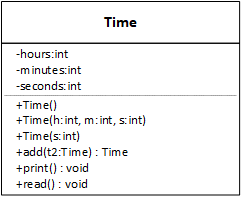
|
|
|||||||||||||||||||||
- A function is not needed to create an "empty" structure object.
- Constructors replace the make_time functions.
- Notice that the member and structure functions have the same total number of parameters. However, the member functions always "hide" one - the implicit this parameter, but structure function parameters are always explicitly visible inside the parentheses. Programs can pass explicit parameters by value, by reference, or by pointer, depending on the need.